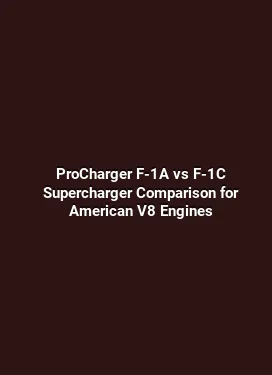Electric Supercharger Kit Review: Do They Really Work for Performance?
Electric supercharger kits have captured the attention of enthusiasts seeking immediate throttle response without the complexity of traditional turbocharging or inline superchargers. This article dives into how these systems function, what gains you can realistically expect, installation considerations, and practical tips drawn from real-world use. Rather than abstract theory, the focus is on actionable details, measurable outcomes, and scenarios that help you decide if an electric supercharger kit is worth the investment for your vehicle and driving style.
Understanding How Electric Supercharger Kits Function and What Sets Them Apart

Electric supercharger kits leverage electric motors to drive a belt or directly spool a compressor, reducing intake air pressure losses at low engine speeds. The result is a more immediate boost compared with some turbocharger systems that rely on exhaust gas availability. A key distinction is that these kits aim to provide a responsive, push-like feeling at mid-range RPMs rather than relying on high exhaust energy to achieve boost. The balance between motor power, compressor size, and intercooling strategy determines how smoothly the system integrates with the engine’s natural breathing, especially in daily driving conditions versus track sessions.
When evaluating a kit, it is important to consider how the electrical system’s supply and cooling apparatus influence performance. Some setups include a dedicated power management unit, an air-to-air intercooler, and temperature sensors that help modulate boost to prevent knock or excessive heat. The ability to monitor system health through data readouts and to tailor boost curves for different fuel grades or octane levels can translate into real-world drivability improvements and protection against engine stress.
Key components and how they interact

At the heart of an electric supercharger kit is a compact, high-torque electric motor coupled to a small compressor. A control module typically handles on-demand activation based on RPM, throttle input, and, in some designs, boost target settings. The compressor pressurizes the intake air, which, after passing through an intercooler, flows into the engine’s intake manifold. The intercooler’s role is crucial: it reduces charge air temperature, increasing air density and mitigating intake heat soak that can negate gains during sustained operation.
A well-tuned kit also accounts for air-fuel ratio management. While the boost can make more air available, the engine’s fuel delivery must keep pace to avoid a lean condition. Some installations rely on the vehicle’s stock fuel system, while others pair the kit with higher-capacity injectors or a retuned engine control strategy. The objective is a harmonious blend of air, fuel, and timing that yields practical performance without compromising reliability.
Real-World Performance: What Drivers Can Expect
Performance claims for electric supercharger kits vary widely depending on the vehicle, engine displacement, gearing, and the kit’s design philosophy. Realistic gains often center around improved throttle response, reduced turbo lag in turbocharged setups, and a measurable bump in mid-range acceleration. It is essential to manage expectations: a kit that is purely electric may deliver more noticeable improvement around 2,000 to 4,000 RPM, where the engine can respond quickly to the additional air, rather than delivering a dramatic peak horsepower increase at higher rpm.
Vehicles with naturally aspirated engines may experience milder improvements, primarily driven by a more efficient cooling path and better volumetric efficiency during certain load conditions. In contrast, forced induction systems that use a belt-driven compressor could see more pronounced results in daily driving and lightweight track sessions, provided fuel and ignition timing are properly calibrated. The practical takeaway is that the kit’s impact is highly conditional on the engine’s baseline performance, fuel system, and the tuning approach used during installation.
Testing scenarios: street, canyon runs, and track days
On a typical street route, a properly configured electric supercharger can enhance throttle response and mid-range torque, translating into crisper acceleration when merging or passing. In a canyon-run scenario, the ability to maintain consistent boost through varied elevations depends on the intercooling effectiveness and the system’s ability to manage heat buildup. On a closed-track session, drivers may notice more sustained boost availability, particularly if the kit includes a robust cooling circuit and a well-mapped control strategy that avoids abrupt boost spikes that could upset traction control or engine safety margins.
The reliability of these outcomes hinges on installation quality, wiring integrity, and heat management. Improper electrical connections or insufficient cooling can lead to underperformance or, in worst cases, electrical faults that limit power delivery. Practical insights from field use emphasize the importance of a clean, routed power supply with proper fuse protection, secure mounting for the compressor and motor, and clear documentation from the manufacturer on compatibility and supported RPM ranges.
Installation Considerations: Fitment, Compatibility, and Safety
The appeal of a bolt-on kit is clear, but compatibility with a given engine family, intake manifold design, and factory electronics determines overall success. Before purchasing, verify the following criteria to avoid misfit or underwhelming results.
- Vehicle compatibility: Some kits are designed for specific makes and models, while others offer broader fitment with adaptable brackets and hoses. A precise fit reduces installation time and minimizes interference with existing components such as the throttle body, intake piping, and intercooler routing.
- Electrical system demand: Electric superchargers draw power from the vehicle’s electrical system. The alternator, battery capacity, and wiring harness should be evaluated to ensure there is headroom for continuous operation, especially in hot conditions or with other high-draw accessories active.
- Cooling strategy: An efficient intercooler and, in some cases, a dedicated radiator or oil cooler help manage heat under sustained boost. Inadequate cooling can erode performance and increase thermal load on the engine.
- Fuel and ignition tuning: For engines with factory calibration, reprogramming or piggyback solutions may be necessary to avoid detonation and to optimize air-fuel mixture as boost is introduced.
- Legal and warranty implications: Some regions restrict electronic boost devices or require emissions-compliant configurations. Additionally, warranty coverage may be affected if the kit alters the factory control strategy or mechanical balance of the intake system.
Optimal installation emphasizes clean electrical grounding, protected wiring routes away from hot surfaces, and a tested boost activation curve that aligns with engine safety margins. Documentation from reputable installers or the manufacturer can guide revision steps, sensor placement, and calibration targets that respect the engine’s tolerances.
Cooling and intercooling: why they matter more than you might expect
Charge air temperature directly influences density. Cooler air carries more oxygen per unit volume, allowing the engine to breathe more efficiently at a given boost. An effective intercooler, whether air-to-air or liquid-cooled, reduces intake air temperature and helps preserve horsepower as boost climbs. Poor intercooling can result in higher knock tendency and reduced efficiency, especially under prolonged heavy loads such as track sessions or hot summer days.
From a practical standpoint, look for kits with insulated charge pipes, well-sealed intercooler cores, and thermally isolated mounting to minimize heat soak. Users who install in climates with high ambient temperatures often see the benefit of auxiliary cooling features, which maintain performance consistency across a wider range of operating conditions.
Maintenance, Durability, and Longevity
Durability hinges on the quality of the electric motor, belt drive components, and electrical harnesses. Regular inspection of belts, pulleys, and mounting hardware helps prevent slippage and boost inconsistency. Electrical connectors should be checked for corrosion, moisture ingress, and secure clamping. In essence, a maintenance-friendly design reduces downtime and helps sustain the perceived benefits over the vehicle’s life cycle.
Longevity is closely tied to heat management and the system’s ability to stay within safe thermal envelopes. A robust cooling solution paired with an intelligently tuned boost curve not only enhances performance during short bursts but also minimizes stress on the engine and intake system. For owners who log data or use performance meters, recording runtime, temperature, and boost trends provides a practical picture of the kit’s impact over time.
Driving comfort and daily usability
Beyond pure numbers, electric supercharger kits can influence daily drivability. A more immediate response at lower RPMs translates into smoother acceleration without large throttle inputs. This can lead to a more confident driving experience in city traffic or on winding roads where quick throttle modulation is beneficial. The trade-off is that some users may notice a slight change in idle behavior or required calibration to harmonize with existing drive-by-wire systems. A thoughtful installation and careful drive mode selection help ensure that everyday use remains predictable and enjoyable.
Trend-Responsive Considerations: Innovation, Market Movement, and Practicality
As vehicle enthusiasts seek ever-greater responsiveness, electric boosting devices have evolved to emphasize rapid spool, compact packaging, and integration with advanced vehicle electronics. Modern kits increasingly feature smart control strategies that adapt boost to throttle input, engine load, and ambient conditions, delivering a more seamless feel than early implementations. The practical takeaway is to prioritize solutions with robust sensor feedback, clear annunciations of boost behavior, and documented heat management strategies. This focus helps ensure that the performance gains are reproducible and reliable across different driving scenarios, rather than being a one-off effect.
Another important facet is the ecosystem around the kit: availability of compatible parts, community support, and reputable performance shops that can validate installation quality. When a kit is supported by detailed installation guides and a network of technicians who can tune for your specific engine and fuel type, owners are more likely to experience consistent results and value over time.
Practical Tips for Maximizing Benefits Without Compromising Reliability
To derive the most value from an electric supercharger kit while maintaining engine safety and reliability, consider the following actionable recommendations:
- Confirm engine health: Before adding boost, ensure piston rings, valves, and compression are in good condition. A solid baseline reduces the risk of undetected issues amplifying with added air.
- Plan a staged approach: Start with conservative boost settings and gradually increase after observing long-term engine response, fuel trims, and sensor readings.
- Invest in cooling: A capable intercooler or cooling loop is often the most cost-effective way to preserve performance under real-world conditions.
- Use quality fuel and correct octane: Boost-aware fueling is critical. Higher-octane fuels can help mitigate knock and unlock more consistent performance.
- Monitor data diligently: Track air temperature, boost pressure, and fuel trims to verify that the system operates within safe regions during varied driving conditions.
- Maintain electrical health: Keep battery and alternator in good shape, and ensure wiring harnesses are protected from heat and vibrations.
These practical considerations help translate theoretical gains into tangible, repeatable improvements in everyday driving and track environments alike.
Conclusion-Free Perspective: Can a Kit Deliver Real Value?
Note: This article provides a comprehensive, practical assessment of electric supercharger kits, focusing on how they work, where gains are most likely, and how to install and maintain them for reliable performance. The discussion emphasizes real-world expectations, careful tuning, and robust cooling strategies to maximize benefits across diverse driving scenarios. A well-chosen, properly installed kit can offer a meaningful improvement in throttle response and mid-range performance without the complexities of larger forced induction systems, provided compatibility and calibration are carefully managed.





